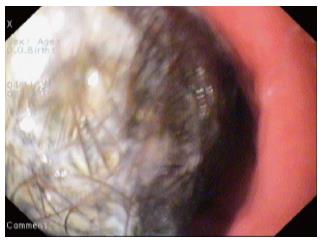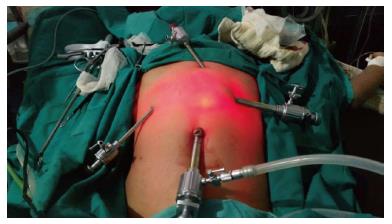Published online May 16, 2015. doi: 10.12998/wjcc.v3.i5.466
Peer-review started: December 18, 2014
First decision: December 26, 2014
Revised: January 29, 2015
Accepted: February 9, 2015
Article in press: February 11, 2015
Published online: May 16, 2015
Processing time: 141 Days and 20.2 Hours
Trichobezoars (hair ball) are usually located in the stomach, but may extend through the pylorus into the duodenum and small bowel (Rapunzel syndrome). Rapunzel syndrome remains uncommon; with fewer than 40 cases reported. To the best of our knowledge, this case may be the first well-documented case with a length of 75 cm. They are almost always associated with trichotillomania and trichophagia or other psychiatric disorders. In the literature several treatment options are proposed, including removal by conventional laparotomy, laparoscopy and endoscopy. Herein, we are reporting an interesting case of an 18-year mentally retarded girl with history of trichotillomania and trichophagia who presented to our emergency department with a history of central abdominal pain associated with vomiting and constipation for five days. An examination showed a trichobezoar requiring emergent surgical intervention, and indicating the need for psychiatric treatment. The trichobezoar was treated successfully by laparoscopy.
Core tip: Laparoscopic management is ideal for trichobezoar due to an improved cosmetic appearance, fewer postoperative complications, and reduced hospital stay. It has a better outcome with many benefits over laparotomy and is slowly becoming the treatment of choice. After trichobezoar removal, prognosis is good if psychiatric therapy to control habitual trichophagia is successful.
- Citation: Jatal SN, Jamadar NP, Jadhav B, Siddiqui S, Ingle SB. Extremely unusual case of gastrointestinal trichobezoar. World J Clin Cases 2015; 3(5): 466-469
- URL: https://www.wjgnet.com/2307-8960/full/v3/i5/466.htm
- DOI: https://dx.doi.org/10.12998/wjcc.v3.i5.466
A trichobezoar is an unusual condition hair bundles in stomach and small intestine, leading to intestinal obstruction usually affecting younger females[1,2]. It is mainly associated with a psychiatric disorder, trichotillomania having tendency of pulling hairs and significant hair loss. The large number of patients with this disorder are having problem of depression, anxiety and poor self-image[3]. The feel pleasant while pulling the hairs. The prevalence of the condition is 0.06% to 4%[4]. Due to smoothness, the ingested hairs resist digestion as well as peristalsis and get accumulated in the gastric mucosal folds. Eating of hairs for a long period leads to trichobezoar. Its main location is in stomach. However, in some cases, there is extension in to small intestine and exceptionally in to large intestine, then the condition is labeled as Rapunzel syndrome. Rapunzel syndrome was first discovered by Vaughan et al[5] in 1968. Fragmentation and dislodgement lead to obstruction[6-8]. As they are clinically asymptomatic, many times there is delay in diagnosing the condition. Due to availability of newer techniques of removal, i.e., Laparoscopy and endoscopy, routinely laprotomy is not preferred[7-9]. Herein, we are reporting a similar interesting case of trichobezoar, removed on laproscopy.
A mentally retarded an adolescent girl (18 years age) came to Jatal Hospital and Research Centre with history of trichotillomania and trichophagia. She was eating her own hairs since last 10 years. She was presented with central colicky abdominal pain along with episodes of vomiting for 7 d. she was clinically conscious, with signs and symptoms of mild dehydration, anemic and had no signs of jaundice. The systemic parameters are normal.
Patient’s upper gastrointestinal diagnostic endoscopy was performed and showed heavy large trichobezoar (hairball) in the stomach (Figure 1). Computed tomography (CT) scan was not done, in view of poor economical status of the patient and also as it was not indicated. Accordingly, patient was planned for emergency laparoscopic management.
A 10 mm umbilical port (telescopic port) was used having 30° telescope. Two 5 mm ports, one at right hypochondriac region and the other at midaxillary line was used. The one used at mid-axillary line was an operating port of 10 mm. Fourth port, i.e., a 5 mm port at epigastric region to retract the left lobe of liver was used (Figure 2).Laparoscopic gastrostomy was performed with the help of harmonic scalpel. There was a giant trichobezoar extending from stomach through pylorus upto the jejunum (Rapunzel Syndrome). Successful complete removal of trichobezoar was done laparoscopically. The length of the trichobezoar was 75 cm. (Figure 3). On follow up patient is doing well since one month and she is under treatment of psychiatrist.
Continued hair ingestion in the patients of trichophagia forms a tight, growing hair balls leading to obstruction in the intestine. After accumulation the hair traps the viscous materials, i.e., mucin, blood that forms tight and compact growing hairballs, not easy to remove[10]. In addition, the gastric churning helps to trap new hair into already formed hairballs. Mucus gives the hairball a shiny surface. Due to denaturation of proteins in the acidic environment of stomach; the color of the ball remains black. The foul smelling breath that results from fermentation of fats[11]. Many times, the patient remains asymptomatic for many years, until the point of obstruction[11]. Subsequent gastrointestinal blood loss leads to anemia.
Depending on the composition they are classified as: Trichobezoars. Phytobezoars, Medication bezoars and Lactobezoars. Phytobezoars are more common that composed of indigestible fruits, vegetable fibers, skin, or seeds[12]. Phytobezoars are mainly associated with a history of previous gastric surgery, conditions of reduced gastric acidity, delayed motility or poor gastric mixing. Medication bezoars composed of undigested tablets or semiliquid drugs. Lactobezoars are predominantly seen in lowbirth- weight or premature babies fed with a highly concentrated milk formula during the first weeks of life[12].
Rapunzel syndrome is defined as a bezoar extending down in to small intestine and exceptionally in to large intestine leading to obstruction[11]. Rapunzel syndrome is very unusual with less than 40 cases documented[11]. It is a reflection of psychiatric illness and no associated with gastrointestinal motility and first discovered by Vaughan et al[5].
Various modalities are used for diagnosis of this rare condition. A contrast upper gastrointestinal series often diagnostic of trichobezoars. They are also easily diagnosed on abdominal ultrasonography and or computed tomography scan[12,13]. However, upper GI endoscopy is an effective diagnostic tool to confirm the presence of a trichobezoar. Endoscopy also helps the clinician to differentiate between a trichobezoar and another foreign body[14].
Several treatment modalities are available for the treatment of trichobezoar, i.e., open surgery, Laparoscopic or endoscopic removal by mechanical fragmentation or using chemicals[11]. The main drawback of above methods is they are not useful in large trichobezoars[14].
Previously open surgery and or laprotomy was a treatment of choice[14]. However, they have postoperative complications, i.e., perforation, infection of wound, pneumonia etc[14]. Other surgical complications are upper digestive tract bleeding, anemia, bowel intussusception and rarely death.
With the availability of newer less invasive modes, laparoscopic removal is preferred but it seems to be difficult. The advantages are less hospital stay, cosmetically accepted and minimal complications[14]. However, there are chances of spillage of hairs into the peritoneal cavity and requires more time[10,14].
To conclude psychiatric treatment and follow up is very important in the treatment and prevention of recurrence of Rapunzel syndrome. The long term prognosis is excellent[11].
Complained of central colicky abdominal pain with episodes of vomiting and constipation.
Trichobezoars.
Computed tomography scan was not performed due to the poor economical status of the patient and also as it was not indicated.
Trichobezoars.
Laparoscopic removal followed by psychiatric therapy is ideal and is successful to control habitual trichophagia in this case.
The authors have performed a good study, the manuscript is interesting.
P- Reviewer: Cruz-Portelles A, Vij M S- Editor: Tian YL L- Editor: A E- Editor: Lu YJ
| 1. | Diefenbach GJ, Reitman D, Williamson DA. Trichotillomania: a challenge to research and practice. Clin Psychol Rev. 2000;20:289-309. [RCA] [PubMed] [DOI] [Full Text] [Cited by in Crossref: 52] [Cited by in RCA: 47] [Article Influence: 1.9] [Reference Citation Analysis (0)] |
| 2. | Carr JR, Sholevar EH, Baron DA. Trichotillomania and trichobezoar: a clinical practice insight with report of illustrative case. J Am Osteopath Assoc. 2006;106:647-652. [PubMed] |
| 3. | Higa-McMillan CK, Smith RL, Chorpita BF, Hayashi K. Common and unique factors associated with DSM-IV-TR internalizing disorders in children. J Abnorm Child Psychol. 2008;36:1279-1288. [PubMed] |
| 4. | Duke DC, Keeley ML, Geffken GR, Storch EA. Trichotillomania: A current review. Clin Psychol Rev. 2010;30:181-193. [RCA] [PubMed] [DOI] [Full Text] [Cited by in Crossref: 115] [Cited by in RCA: 93] [Article Influence: 5.8] [Reference Citation Analysis (0)] |
| 5. | Vaughan ED, Sawyers JL, Scott HW. The Rapunzel syndrome. An unusual complication of intestinal bezoar. Surgery. 1968;63:339-343. [PubMed] |
| 6. | Naik S, Gupta V, Naik S, Rangole A, Chaudhary AK, Jain P, Sharma AK. Rapunzel syndrome reviewed and redefined. Dig Surg. 2007;24:157-161. [RCA] [PubMed] [DOI] [Full Text] [Cited by in Crossref: 97] [Cited by in RCA: 112] [Article Influence: 6.2] [Reference Citation Analysis (0)] |
| 7. | Tudor EC, Clark MC. Laparoscopic-assisted removal of gastric trichobezoar; a novel technique to reduce operative complications and time. J Pediatr Surg. 2013;48:e13-e15. [RCA] [PubMed] [DOI] [Full Text] [Cited by in Crossref: 25] [Cited by in RCA: 26] [Article Influence: 2.2] [Reference Citation Analysis (0)] |
| 8. | Pogorelić Z, Jurić I, Zitko V, Britvić-Pavlov S, Biocić M. Unusual cause of palpable mass in upper abdomen--giant gastric trichobezoar: report of a case. Acta Chir Belg. 2012;112:160-163. [PubMed] |
| 9. | Kanetaka K, Azuma T, Ito S, Matsuo S, Yamaguchi S, Shirono K, Kanematsu T. Two-channel method for retrieval of gastric trichobezoar: report of a case. J Pediatr Surg. 2003;38:e7. [RCA] [PubMed] [DOI] [Full Text] [Cited by in Crossref: 29] [Cited by in RCA: 34] [Article Influence: 1.5] [Reference Citation Analysis (0)] |
| 10. | Fraser JD, Leys CM, St Peter SD. Laparoscopic removal of a gastric trichobezoar in a pediatric patient. J Laparoendosc Adv Surg Tech A. 2009;19:835-837. [RCA] [PubMed] [DOI] [Full Text] [Cited by in Crossref: 19] [Cited by in RCA: 19] [Article Influence: 1.3] [Reference Citation Analysis (0)] |
| 11. | Gonuguntla V, Joshi DD. Rapunzel syndrome: a comprehensive review of an unusual case of trichobezoar. Clin Med Res. 2009;7:99-102. [RCA] [PubMed] [DOI] [Full Text] [Cited by in Crossref: 86] [Cited by in RCA: 107] [Article Influence: 6.7] [Reference Citation Analysis (0)] |
| 12. | Lin CS, Tung CF, Peng YC, Chow WK, Chang CS, Hu WH. Successful treatment with a combination of endoscopic injection and irrigation with coca cola for gastric bezoar-induced gastric outlet obstruction. J Chin Med Assoc. 2008;71:49-52. [RCA] [PubMed] [DOI] [Full Text] [Cited by in Crossref: 22] [Cited by in RCA: 24] [Article Influence: 1.4] [Reference Citation Analysis (0)] |
| 13. | Taori K, Deshmukh A, Rathod J, Sheorain V, Sanyal R. Rapunzel syndrome: a trichobezoar extending into the ileum. Appl Radiol. 2008;34-35. |
| 14. | Gorter RR, Kneepkens CM, Mattens EC, Aronson DC, Heij HA. Management of trichobezoar: case report and literature review. Pediatr Surg Int. 2010;26:457-463. [RCA] [PubMed] [DOI] [Full Text] [Full Text (PDF)] [Cited by in Crossref: 163] [Cited by in RCA: 170] [Article Influence: 11.3] [Reference Citation Analysis (0)] |











